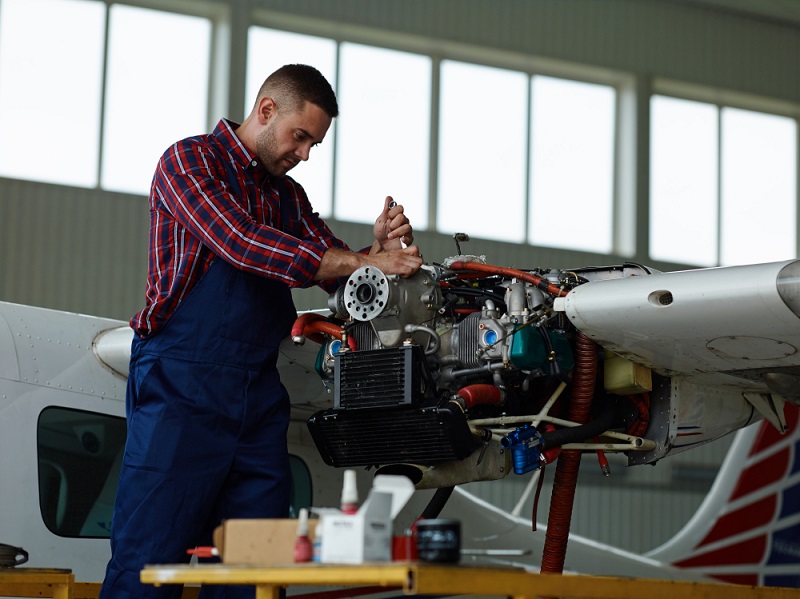Take To the Skies: Essential Tools For Modern Aircraft Mechanics

The safety of passengers, crew, and cargo is ensured by aircraft maintenance, which is a crucial component of the aviation industry. This explains why the aviation sector in the United States employed more than 131,500 service technicians and aircraft mechanics in 2017.
As they are working with one of the most delicate machines ever created, mechanics and technicians who perform various services, such as repairing and maintaining aircraft, need to have the necessary training and experience. So what are the best aircraft tools for aircraft maintenance?
It is crucial to emphasize that maintaining an aircraft necessitates more than just education, training, and experience. Advanced tools and equipment are also needed. To perform quality repair and maintenance, technicians must have modern aviation equipment.
Commonly Used Tools for Aircraft Maintenance
In this section of the article, we will help you find out about some of the most crucial aircraft tools and equipment used to maintain aircraft. Read on to know more in detail to have an overall better understanding!
Quick Handle
Civil aviation mechanics don’t have enough time to move from one aircraft to another while trying to fix the issue. A significant amount of work needs to be completed quickly. One of the most cutting-edge tools for maintaining aircraft is a speed handle. Due to its length, technicians can spin the screw fast and take the screw head off by using one hand while using the other to perform other repairs. This is one of the most crucial aircraft tools, especially when working on an expensive engine with many screws.
Torque Wrench
The majority of the screws and fasteners on the helicopter rotor must be installed to a specific torque or tightness. However, most spanners available for tightening a bolt or nut are ineffective at fastening different screws. Only a calibrated torque wrench can be relied upon to tighten a nut to a particular torque. Because most torque wrenches can be adjusted to various torque levels, they are instrumental in maintaining and repairing aircraft.
Safety wires are indispensable additions to the array of tools employed in aircraft maintenance, providing an additional layer of security to prevent loosening of nuts and bolts. Despite meticulous efforts to ensure proper torque and functionality of fasteners, safety wires offer an extra safeguard against potential issues. Typically, large aluminum wires are meticulously braided using specialized safety wire pliers, resulting in exceptionally robust braids. Through firm tying techniques, these wires are intricately secured to impart maximum toughness, bolstering the integrity of the aircraft’s structural components and enhancing overall safety during flight operations.
Vibration Meter
An aircraft’s vibration analysis is crucial to ensuring its safety while in the air. The purpose of a vibration meter is to gauge the aircraft’s vibration levels. The maximum vibration an airplane can withstand is indicated by a vibration meter that weighs in kilograms. The pilot can maintain the safety and integrity of the aircraft by acting appropriately by understanding the vibration magnitude on the aircraft with the aid of a vibration meter. Without a vibration meter, an aircraft is doomed to suffer from:
- Structural integrity problems,
- Rotor blade issues, and
- Other catastrophes
Pliers for safety wire
Safety wires are also added to the list of aircraft tools to ensure that the nuts and bolts never loosen, even though a lot of work is put into ensuring that most of the fasteners are functioning as intended and using the proper torque. Large aluminum wires are held and braided using safety wire pliers to create extremely robust braids. To guarantee that there are no issues with the nuts and bolts, the wires are “tied” firmly and with the greatest amount of toughness.
Metalworking Instruments
Metal is used in aircraft construction, particularly in the mainframes and structures. Therefore, the required metal working tools must be available for mechanical repair. To fasten metal, bend metal, and cut metal, the majority of metalworking tools are used. Drills and rivet guns are two common metalworking aircraft tools that are primarily used to install rivets, which are crucial for holding the fundamental aircraft structures together.
Mirrors
Mirrors are other necessary aircraft tools used in aircraft repair, despite the way they appear. There are some parts of the aircraft that mechanics typically don’t see. Some crucial components that need to be checked regularly are out of the technicians’ direct line of sight. Sometimes, rather than tearing apart the entire wing, a mirror is the sole method of seeing this kind of area.
Conclusion
These are just a few aircraft tools and supplies frequently used when repairing an aircraft. A cockpit voice recorder and a flight data recording system are two sophisticated components of aeroplanes. You need to purchase these aircraft tools from a qualified and specialized dealer to analyze these parts.





